Queen Sirikit Botanic Gardens, Chiang Mai
And memories of working at Kew and thoughts on botanic gardeners
Chiang Mai is the capital of the north of Thailand and sits up on a high plain surrounded by mountains in the area known as the Thai highlands. And here sits the Queen Sirikit Botanic Gardens, the Kew Gardens of Thailand. Established in 1992, they are probably the newest botanic gardens I have been to. Along with their four satellite gardens across the country, they are Government funded and are primarily research and environmental conservation projects.
Each of the five gardens grows plants suitable to their particular geographical area. Thus Rayong had the ancient Samet forest, the mangroves and the water lilies; another one specialisms in halophytes, (salt tolerant plants). Yet another grows mainly orchids and the last is agricultural research. Unfortunately, I wasn’t going to be able to visit them all, mainly because the others are so remote and I am simply not brave enough to drive long distances around Thailand. Maybe one day...
To get to Queen Sirikit is only forty-five minutes out of Chiang Mai. With no public transport to the gardens, I got a Grab Taxi. On arrival, to my surprise, the cabbie suggested she stay and drive me round and then take me home after about an hour. I explained that I needed a bit more time than that and that I would be fine walking. She looked at me as if I was slightly crazy and off she drove.
I surveyed my surroundings to see that I was in a large car park from which a steep tarmac road curved up into what appeared to be dense jungle. I went to buy a ticket at the car barrier booth, and the woman said to me: “Where is your car, your driver, how did you get here?” Slightly embarrassed, I had to admit to dismissing the taxi and that I was just here alone on foot. She shook her head and tutted. “Can I not just walk round these gardens?” I asked her. “Not really possible; too far.” she replied. I asked about scooters, (not allowed); the trucks that were parked up, (tours only). This all seemed madness to me. What sort of botanic gardens were these that you could not visit on foot?! I clearly hadn’t done my research properly; I had dispersed with my driver and now I was a bit stuck, to say the least.
I needed to think, so I went to the lovely garden’s café and had a relatively expensive coffee and croissant whilst studying the map, trying to work out how far I would be able to walk up a small mountain in 30 degrees with a slightly impaired left foot. I watched a bus arrive with about fifty young monks on it who merrily got on two of the electric trucks which trundled up the hill. Then another bus arrived and around 30 elderly people clambered off and, following a man with a flag, were marched over to another truck.
The Botanic Gardens Cafe
As their guide went to the ticket office, I could see the woman there talking to him and then gesturing to me, so I quickly trotted over, my hopes up. But he turned to me and said: “Sorry no space, My tram is full.” However, he quickly must have taken pity when he saw my expectant face drop: “Ok, no problem, you have my seat.” So there I was was next to the driver in the tour guide’s seat with the American OAP’s chattering excitedly behind me. The guide sat on the drinks box facing them. I offered more than once to swap with him but he insisted he was fine and, anyway, he said, he could talk to them better this way. He then told us all that the gardens were over 1000 hectares and there were lots of different areas but that we would be visiting just three: the Canopy Walk, the Glasshouse Complex and the Waterfalls. The trip would last about an hour and a half he explained. I was very pleased. My expectations had dramatically reduced by then so anything was a bonus.
The truck chugged up the steep hill and we drove past intriguing signs, such as ‘Banana Avenue’ and ‘White flower Garden.’ Oh well. I was never going to be able to see everything. I also had to remind myself that the primary purpose of botanic gardens is floral research and biodiversity. Creating an aesthetically pleasing garden for the public to visit is secondary.
The Canopy Walk made up for any disappointment as not only was it extremely high above a proper jungle, so that you can look down upon the tree tops, which is an unusual position to find oneself in, but there was also the awe-inspiring view over the distant mountains. Suddenly this seemed like a great place for a botanic garden.
View from the Canopy Walk
The light barely penetrated the dark forest floor below, so thick was the vegetation. I wondered what else was down there. The cicadas were deafening but punctuated by shrieking tropical birds. Many of the giant trees towered above the walkway. Some, which were close were botanically labelled, most of which I had never heard of, including Mallotus paniculatus, Glochidon sphaerogynum, and Alangium kurzii. Although Toona ciliata in the mahogany family was familiar to me, and there were lots of different Pines, palms and tree ferns. There was also information about a ‘flying’ lizard, Draco maculatus, which has a web of skin over its ribs allowing it to glide for up to 9 meters, giving the impression that it flies. Unfortunately I didn’t see any, not surprising as they are well camouflaged.
I was reminded that there is a new Treetop Walkway at Kew Gardens which I have yet to get to. Although it may pale slightly in comparison to this, at least there is public transport to Kew and you can walk round the gardens. That got me thinking about the gardeners here in Queen Sirikit and whether or not the gardeners and arboriculturists actually work on the forest floor, carrying out maintenance and tree surgery to keep things under control, or was the forest just left to be completely natural without any intervention? Peering down it looked impenetrable and once in, how would you ever find your way out? The Tour Guide was busy with his Americans so I didn’t really feel that I could take further advantage of his generosity by plying him with questions.
Looking down over the treetops, Canopy Walk
We all then climbed back on the truck and wound our way higher up this small mountain to our next destination; the Glasshouse Complex. This consisted of about ten glasshouses; I practically to run round them to see them all in time; the main one was impressively large with a Tropical Rain Forest zone complete with waterfalls, a large Temperate zone, an internal high walkway, cycads, etc. The others were divided into plant families, including Cacti, Orchids and Ferns (combined), Carnivorous plants, Bromeliads, The Lotus and Water Lily House etc.
Orchid and Fern House
Monks inspecting mock Venus Fly Trap in The Carnivorous Glasshouse
Echinocactus grusonii (Golden Barrel Cactus) in Cacti House
Two that stood out for me were the Medicinal and Wellbeing Glasshouse and the Ethnobotanical Glasshouse. As expected the Medicinal and Wellbeing Glasshouse had plants that were the source of medicines, drugs, herbs, well-being and aromatherapy. Plants included Clausena hamandiana, the bark of which has been used in folk medicine for stomach pains and headaches, but is now used to tackle cognitive decline and is being researched as a medication for Alzheimer’s.
The Ethnobotanical Glasshouse was new to me. A notice explained that ethnobotany is: “the multidisciplinary study of the relationship between humans and plants, … a science of survival, … a source of inspiration and material for innovative development and current knowledge such as food security, drug development, tourism and promoting social awareness of the importance of biodiversity conservation.”
Exhibits included re-created houses, tools, food etc of five different tribes who live in the surrounding mountain area; the Hmong, the Shan, the Lua, the Karen and the Tai Yuan.
The Shan Tribe exhibit
So for example, one of the plants that they focused on is Senna siamea (Siamese Cassia) a hardwood used for building but the leaves of which are used for a whole range of illnesses by most of the different tribes, including typhoid, jaundice and abdominal pains. The leaves are also used in traditional cuisine.
Senna siamia (Siamese Cassia)
I subsequently met some of the Karen people including the White Karen on a trip out from Chiang Mai, and later the Long-necked Karen near Chiang Rai. The White Karen appear to continue to live a largely traditional way of life. They still build their houses out of bamboo as this is a much cheaper wood than hardwoods that have to be imported. The houses don’t have windows because they let in sufficient breeze through the gaps in the bamboo. Now of course,, compared to the exhibits, they have electricity, mobile phones, satellite dishes and a reasonable supply of running water.
Bamboo houses in a White Karen Village, Thai Highlands
The White Karen had previously been growing opium and then been encouraged by the Government to grow other crops which, however, continued to cause deforestation. They are currently growing and selling coffee which is seen as sustainable in that the plants grow under the canopies of other trees. But clearly they really struggle to make ends meet.
The Long Neck Karen, (also known as Kayan) which are a sub-group of the Red Karen, are refugees in Thailand from Myamar. They are called the Long Necks because the women wear brass coils around their necks which causes their shoulders to slope downwards and gives the impressive of them having a very long neck. Traditionally, it was also designed to help give protection from tiger attacks but it is also considered to be beautiful like a swan’s neck. The older they get the more rings they wear. The girls start to wear the rings at age five, and not till are they 15 can they choose whether to continue or not. The choice at that age is significant because the damage to their neck and rib cage becomes too severe after that to stop wearing them. Visiting the Long Neck Karen women (which was a diversion as part of a trip out to some temples) felt a bit like going to a human zoo or exhibit. It is concerning that their main income is probably from tourism which means that they may continue to wear the rings for tourists like me. This was not what I had in mind as part of my travels.
Long-Neck Karen in village near Chiang Rai
I wondered what it would be like to work here at Queen Sirikit; what were the gardeners like, were they enthusiasts, were they paid a reasonable wage and did they all travel in from Chiang Mai every day? I tried to talk to some of the gardeners there but language difficulties got in the way. However, my impression, from their demeaner and their quiet tendering of the plants, was that they were enjoying their work. It got me thinking about working at Kew in the mid 1980’s. I had already been working for a couple of years in horticulture when I got to Kew, but it was very different from anywhere else I’d worked before, or since. Most of the people working there were plant people, rather than gardeners; the difference in my view being that, rather than someone who is into the act of creating a beautiful space, or a design, or who just love gardens for what they are, Kew people seemed to be obsessive about plants, and especially the particular group of plants that they are working with. The plants that we worked with became part of our identity. For example if you were in Tropical, which I was for four years, those plants became yours and you got totally into them. As they did for those in Temperate, Alpine, the Arboretum, Palms; etc. And then you had your further specialism, so us lot in Tropical focused on either Cacti, Ferns, Orchids etc. I was Ferns. Perhaps a strange thing to do for four years from the age of 18; I probably should have been backpacking round South East Asia!
One of the unusual things about working at Kew was that, unlike if you worked for the local council or a garden centre etc, most people at Kew weren’t local. They had applied for the job and came from all over the UK and beyond. This meant that they had to move to London to work there, which wasn’t the easiest thing to do if you weren’t from there. Social media has probably changed all that now, but then it was a much more difficult place to settle into. As a result, the people of Kew tended to build their life around work. It was a Kew Gardens bubble where you socialised with as well as worked with, and often lived with, other Kew gardeners. It was a bit like being in one large, rather dysfunctional, family. I lived in at least three different houses with other Kew Gardeners during my time there.
Being around nature, greenery and somewhere beautiful, can only really be good for you, particularly if you are living in the Big Smoke. Going through that gate in the wall every morning, whether it was snowing or a wonderful Spring day, was like travelling into a different world where you could completely shut out the hustle and bustle of London life. I remember my interview for the Kew job well; there were five people on the panel! One of the questions they asked was what makes a botanic garden different from most other gardens you visit. Of course it is the fact that the plants are labelled, and labelled properly, and mainly arranged in families or geographical groups. Also, at Kew they only grew natural species, or at least they did when I was there, rather than ‘man-made’ varieties or hybrids. That was where we differed from the Royal Horticultural Society. Kew was a truly wonderful place to work and really a privilege to be working with the largest collection of plants in the world.
In the 1980’s people were surprised when I told them that I was a gardener. Even though there were lots of women gardeners at Kew, that was an exception. When I went on my day release City and Guilds course, I would be the only girl there. But for some reason Kew was progressive in that way, perhaps because it could identify the enthusiasts, many of whom of course were and are women.
It is good to see lots of women gardeners working in gardens in Thailand and the other South East Asian countries I have recently visited. It would be interesting to know if it has always been the case here. Thailand is quite progressive in terms of that it was one of the first Asian countries to give women the vote and it has anti-discrimination laws including equal pay for equal work. Since gardening has always been a female as well as a male occupation, back to when time began, it is odd that for decades but especially in the 1970’s and ‘80’s, it was seen as a predominately male thing in the UK, and people thought it was odd a woman wanting to be a gardener. Charlie Dimmock, amongst other female TV gardening personalities, did well in changing attitudes to all that in the 1990’s.
Aristolochia elegans (Elegant Dutchman’s Pipe)
One of my favourite flowers, that I saw at Queen Sirikit in the Carnivorous Glasshouse, is the Aristolochia of which there are lots of different species with large interesting flowers. A. elegans is not strictly an insect-eating plant; it has a strong scent that attracts flies and then traps them in its perianth with hairs. But when the fly has been fully covered in it’s pollen, the hairs wither and die and the fly is released to go and pollinate a neighbour. The name Aristolochia is derived, not from Aristotle as I first assumed, but from aristos (best) and locheia (childbirth) because the plant was once used to help with delivering the placenta in ancient Greece. Hopefully no longer because it contains aristolochic acid which is a lethal toxin and is now known to cause kidney disease and is carcinogenic. Perhaps that is why it was not in the well-being Glasshouse.
Our final stop at Queen Sirikit was the waterfalls. This was back down the hill and involved going on a short walk into the forest to a river and waterfall surrounded by trees covered in orchids, staghorn ferns and Epipremnums. And that was the end of the tour. The Americans all went off to an elephant sanctuary and I walked back to the cafe. I was about to order a cab when a man suddenly appeared asking if I wanted a taxi back to the city. Where he popped up from I have no idea, but probably something to do with the ticket officer who seemed to have been keeping an eye on me and helping me out all day. I jumped in and was ‘home’ before I knew it.
The electric truck
The Monks leaving the gardens

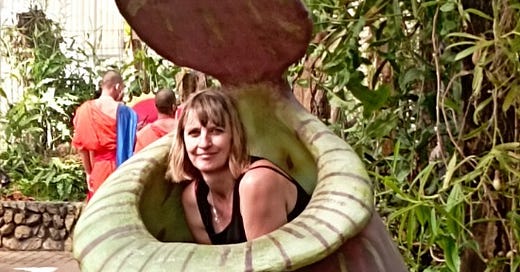



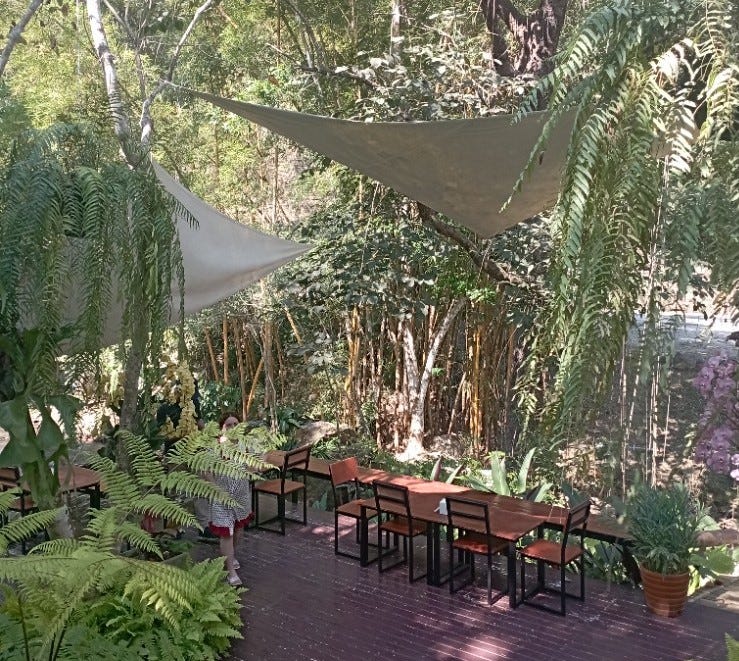
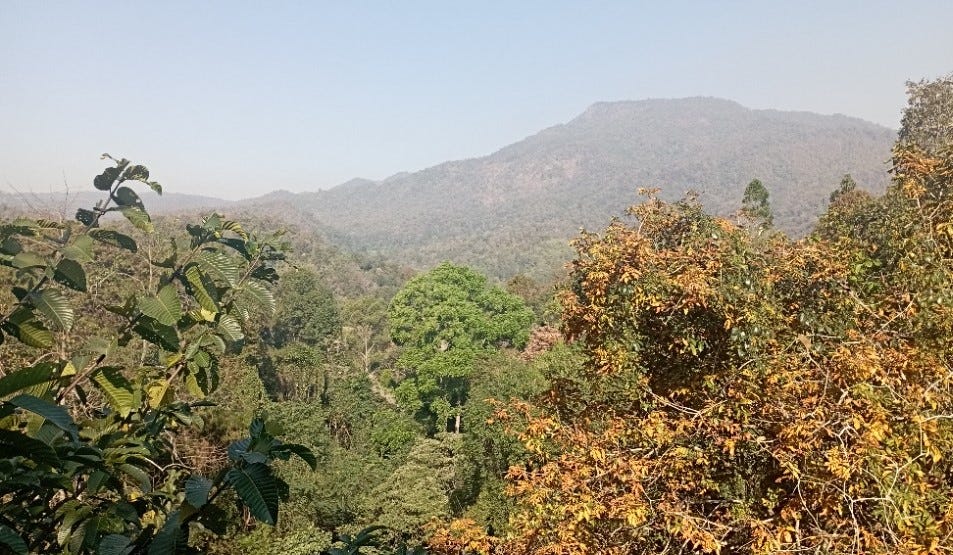
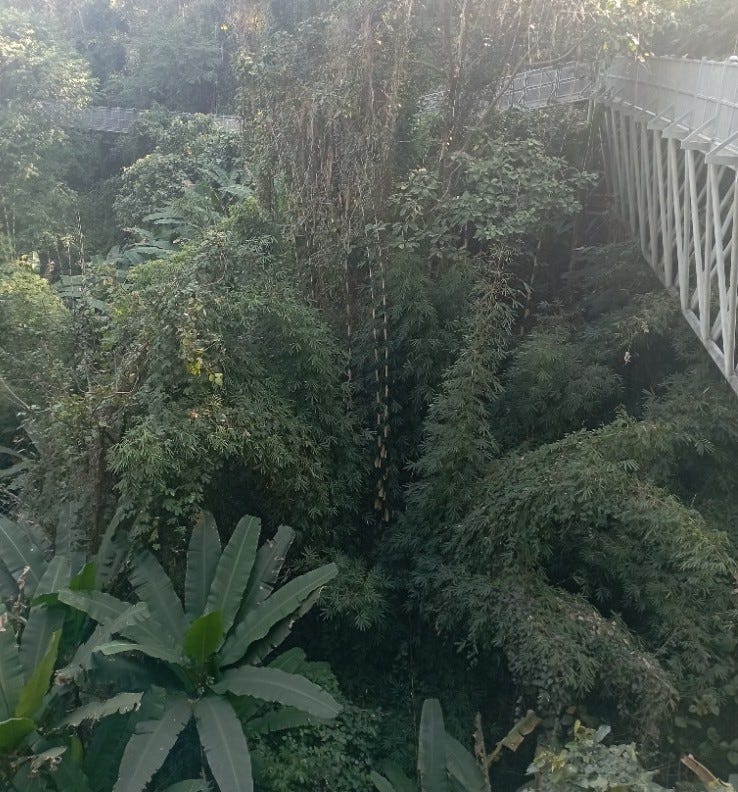
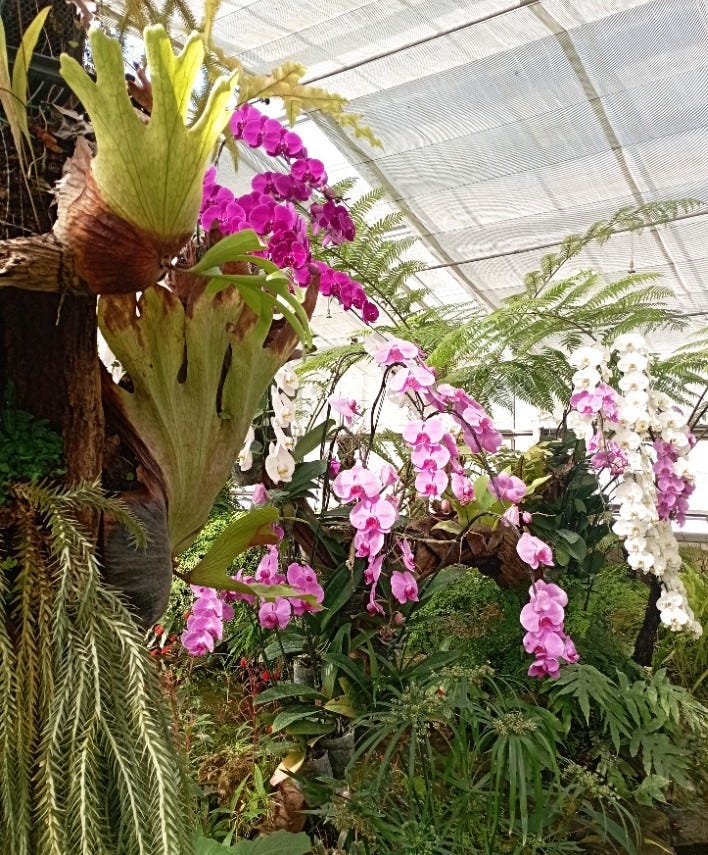
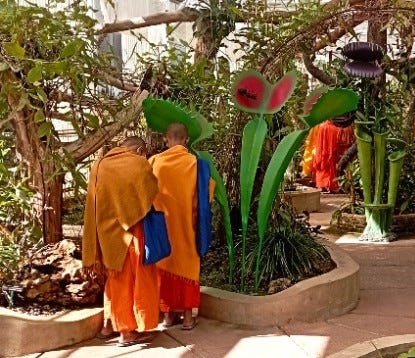
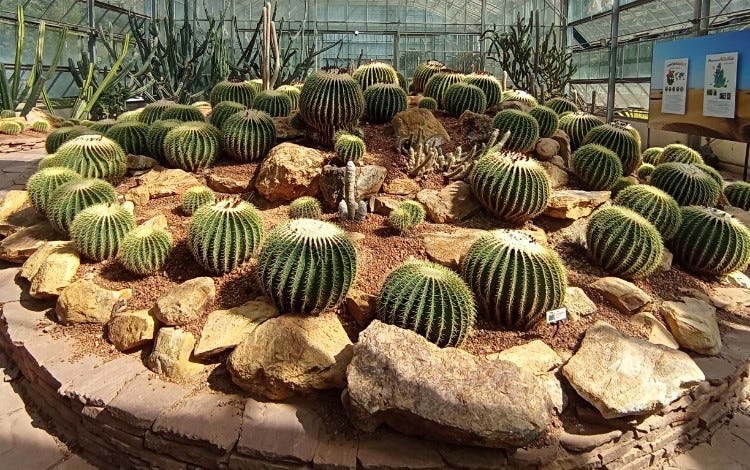
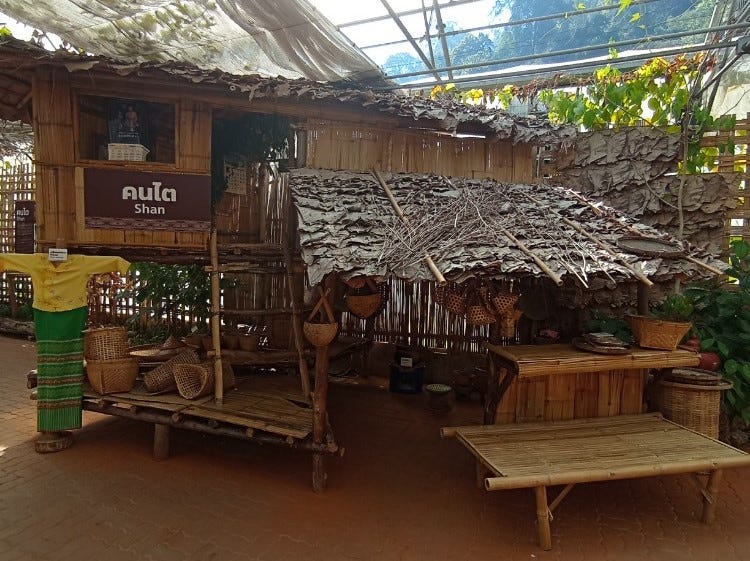
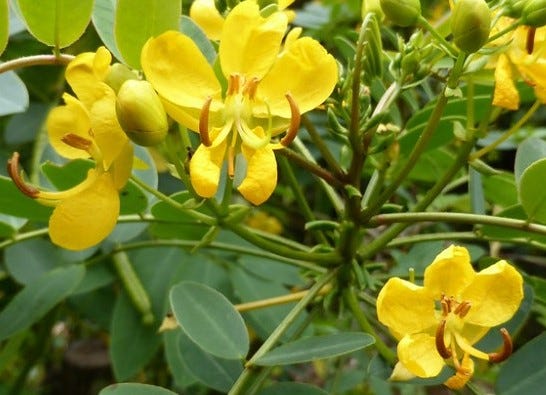

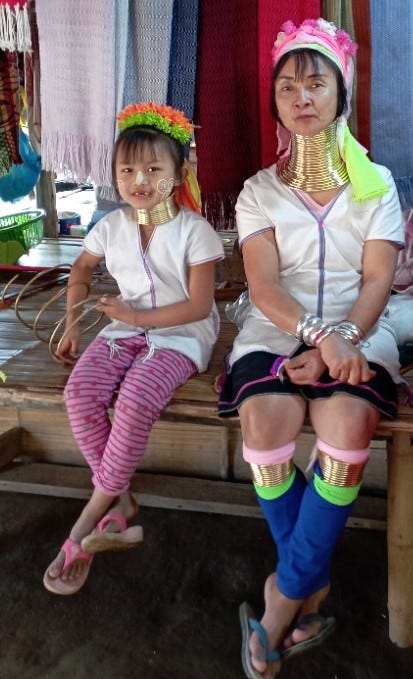
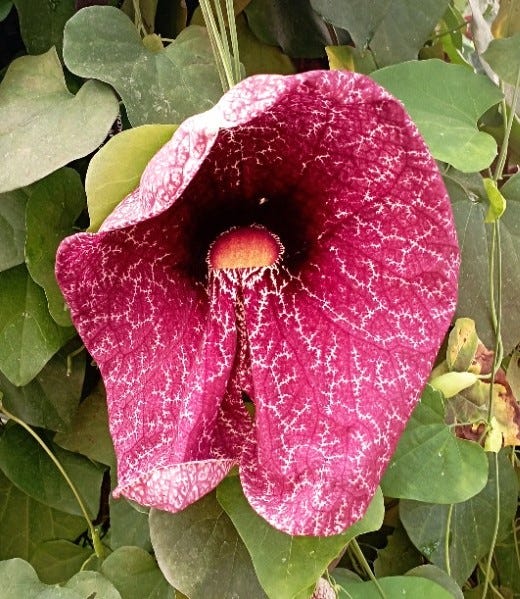
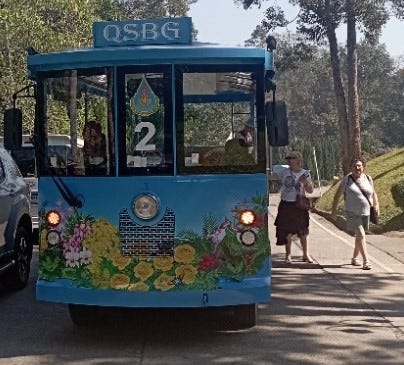
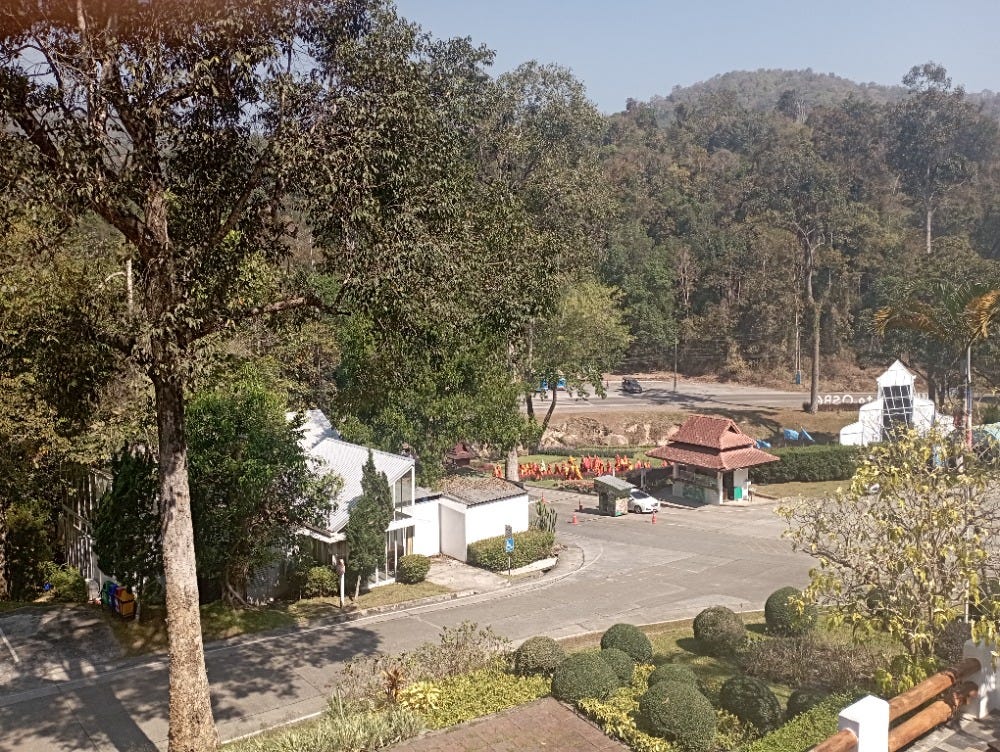
Haha, yes that was a model Venus Fly Trap that the monks were peering into. They also had model carnivorous plants that you could climb into and have your photo taken which one of the American women did for me but too ridiculous to include in the blog!
Wonderful photos again! Love the cacti in the cactus house and the monks inspecting the Venus flytrap. Also very enjoyable reading your reminiscences of Kew and reflections.❤